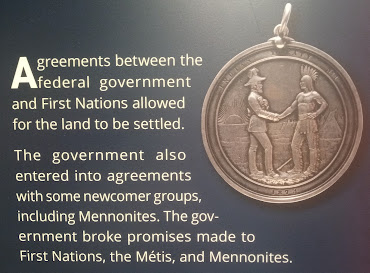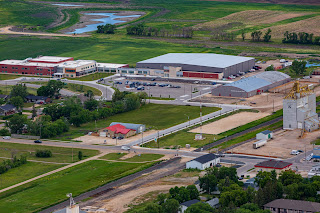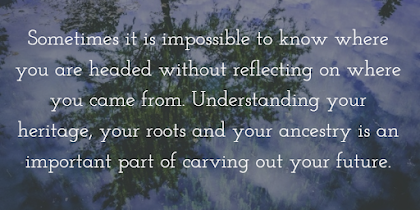A Summary of Events on Niverville's Journey Towards Truth and Reconciliation since September 30, 2021
The Opening of Niverville's Cultural/Historical Museum on September 30, 2021 -- Part 1
Summary
Unlike other communities within the present-day Rural Municipality of Hanover, Niverville was more cosmopolitan and cross-cultural right from the start, comprising English, Scottish, Mennonite farmers, and eventually Jewish, Arab, German, French, Chinese and multiple other ethnicities, giving us an inside track for pursuing inter-cultural communication, understanding and reconciliation. With the opening of the Niverville Museum on September 30, 2021 (on the first National Day for Truth and Reconciliation), however, more of our people are coming into a greater awareness and appreciation for the role of the First Nations and the Métis with their earlier connection to the land. The Indigenous worldview is that people and land are connected. Could greater reconciliation between pre-settlement and post-settlement peoples be a key to greater healing of the people and the land?
With the First Nations, Métis and Mennonites, we have three people groups from different cultural backgrounds. All three groups have historically lived off of the land rather then from government largesse. Yet the Government of Canada made special paternalistic promises to each group in an effort to accommodate their cultural values and beliefs. The Manitoba Act of May 12, 1870, sought to address Métis concerns. Treaty No. 1 signed on August 3, 1871, sought to address First Nation's issues, and the Mennonite Privilegium signed by the Government on July 23, 1873, sought to accommodate Mennonite values. In each case, however, the Government ended up coming short of expectations because of a lack of a depth of cultural, relational and mutual understanding.

So things that all three cultural groups have in common was 1) a disappointment with the federal government's paternalism and assimilationist policies. There is also agreement in that 2) all three people groups were a land-based people with 3) a belief in the Creator. If you would like to dig deeper into this topic, and read a more in-depth account of the opening of The Opening of Niverville's Cultural/Historical Museum -- Part 1, please click here.
The Opening of Niverville's Cultural/Historical Museum on September 30, 2021 -- Part 2
Summary
The values and the beliefs of the First Nations, Métis and Mennonites (as representatives of both pre-settlement and post-settlement times) and the Canadian Government were all rooted in a spirituality, a belief system, a way of looking at life. However, they had different views on the Creator's relationship to the land, and about who owned the land, and about whether humans were owners or stewards of the land. The Declaration of First Nations by the Assembly of First Nations of Canada states that "We, the Original Peoples of the land know the Creator put us here." Further, as the Reconciliation Proclamation that came out of Elijah Harper's Sacred Assembly on December 9, 1995, declares: "We share the recognition that reconciliation between Indigenous and non-Indigenous Canadians must be rooted in a spiritual understanding of land as a gift from the Creator God."
The Métis Provisional Government in its Declaration of the People of Rupert's Land and the North-West on December 8, 1869, declared to the Canadian Government their decision to "invoke the God of Nations" as the basis of their appeal for justice between nations. Moreover, the Mennonites overcame huge obstacles in proving that one could wrest a living through agriculture on this unforgiving land "through courage and faith in God," as the cairn at the Mennonite Landing reminds us. Yet, they were all trying to become compatible within a Domination System that was not between equals. At the end of the day, the federal government had the top-down clout to enforce their policies under the threat of punishment. Yet the spiritual beliefs of these people was much more egalitarian, beliefs that embrace the supremacy of God our Creator, and the dignity and worth of every human person.
Hence, our need to respect the land, share in the harvest, and be generous and serving of one another, and sharing with one another, rather than being dominating, controlling and selfish. To go deeper into this history, read the full report of The Opening of Niverville's Cultural/Historical Museum -- Part 2 at this site.
The Ribbon-cutting for an Authentic Métis Red River Cart in Niverville on December 4, 2021
Summary
A local group who had been collaborating with Joseph Wiebe on the design of the Niverville Historical/Cultural Museum decided that they would like to see the museum's theme enhanced by a symbolic representation that could speak to both the pre-settlement and post-settlement content conveyed by the Museum itself. It dawned that an icon such as an authentic Métis Red River Cart was an appropriate symbol on at least three levels.
First of all, the route of the historic Crow Wing Trail that was used by the Métis Red River Cart Brigades for the purpose of international trade between 1844 and 1878 ran directly through present-day Niverville. Secondly, not only was the cart representative of the Métis in our local history. It was also a connecting and transitional link to the Mennonites and post-settlement people during the time of transition. Thirdly, the Métis nation represents the joining of two cultures, indeed, the mixing of two distinct cultures, European and First Nations, to create a unique and distinct culture that can build bridges of understanding between the two different worlds.
To gain a more in-depth perspective on The Ribbon-cutting for an Authentic Métis Red River Cart in Niverville on December 4, 2021, read the full report.
The Unveiling of the Cairn at the Site of the Shantz Immigration Sheds on Manitoba Day, May 12, 2022
Summary
By the time of the unveiling of the cairn at the site of the Shantz Immigration Sheds on Manitoba Day, May 12, 2022, with some 90 community leaders present, it was becoming clear that this site was not only an important part of the Mennonite story, but a part of the Métis story in Manitoba as well. Hence, the M & M & M (Mennonite and Métis in Manitoba) Connection.








Comments
Post a Comment